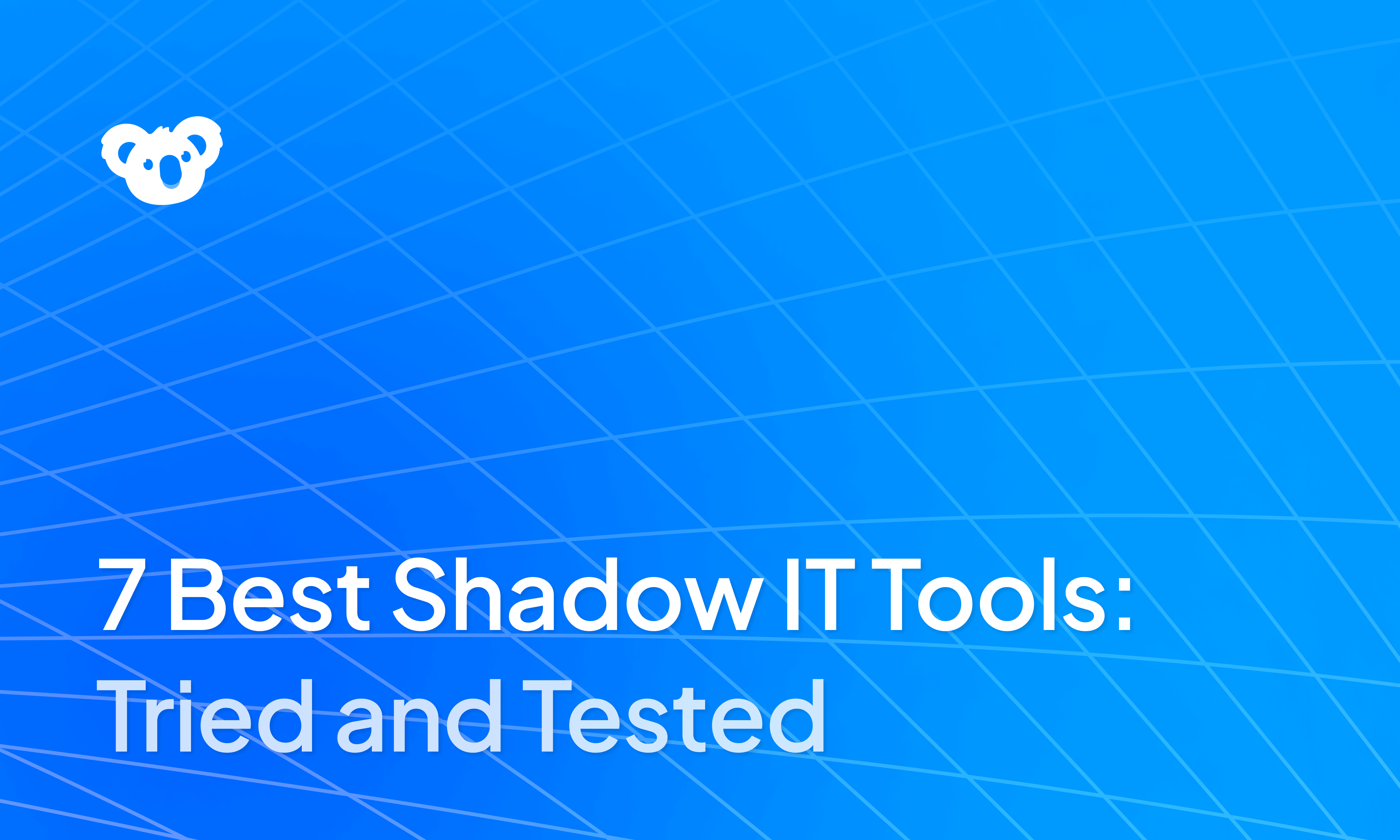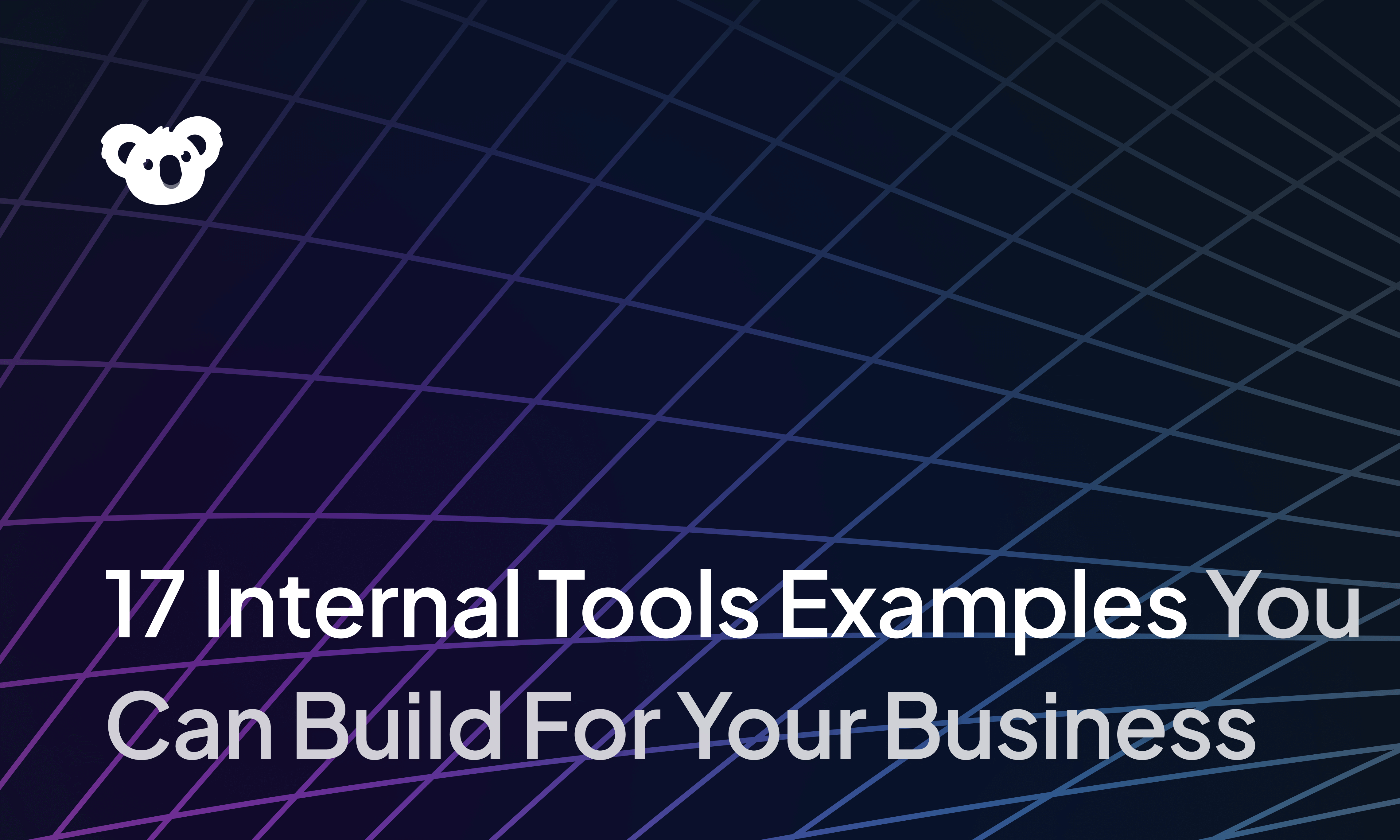


When choosing an enterprise AI app generation platform, pick Superblocks for secure internal tools, Cursor if you're a developer who wants AI coding assistance in the IDE, and Lovable for rapid prototyping before handing off to engineering. These platforms cut months off development time and empower domain experts.
In this article, we’ll cover:
- The 7 best AI app generation platforms for the enterprise
- The key features, pros, cons, and pricing for each tool
- Which tool to choose for your use case
Best enterprise AI app generation platforms: TL;DR
If you're short on time, here's a quick overview of the top enterprise AI app generation platforms.
The table compares their use cases and starting prices:
1. Superblocks
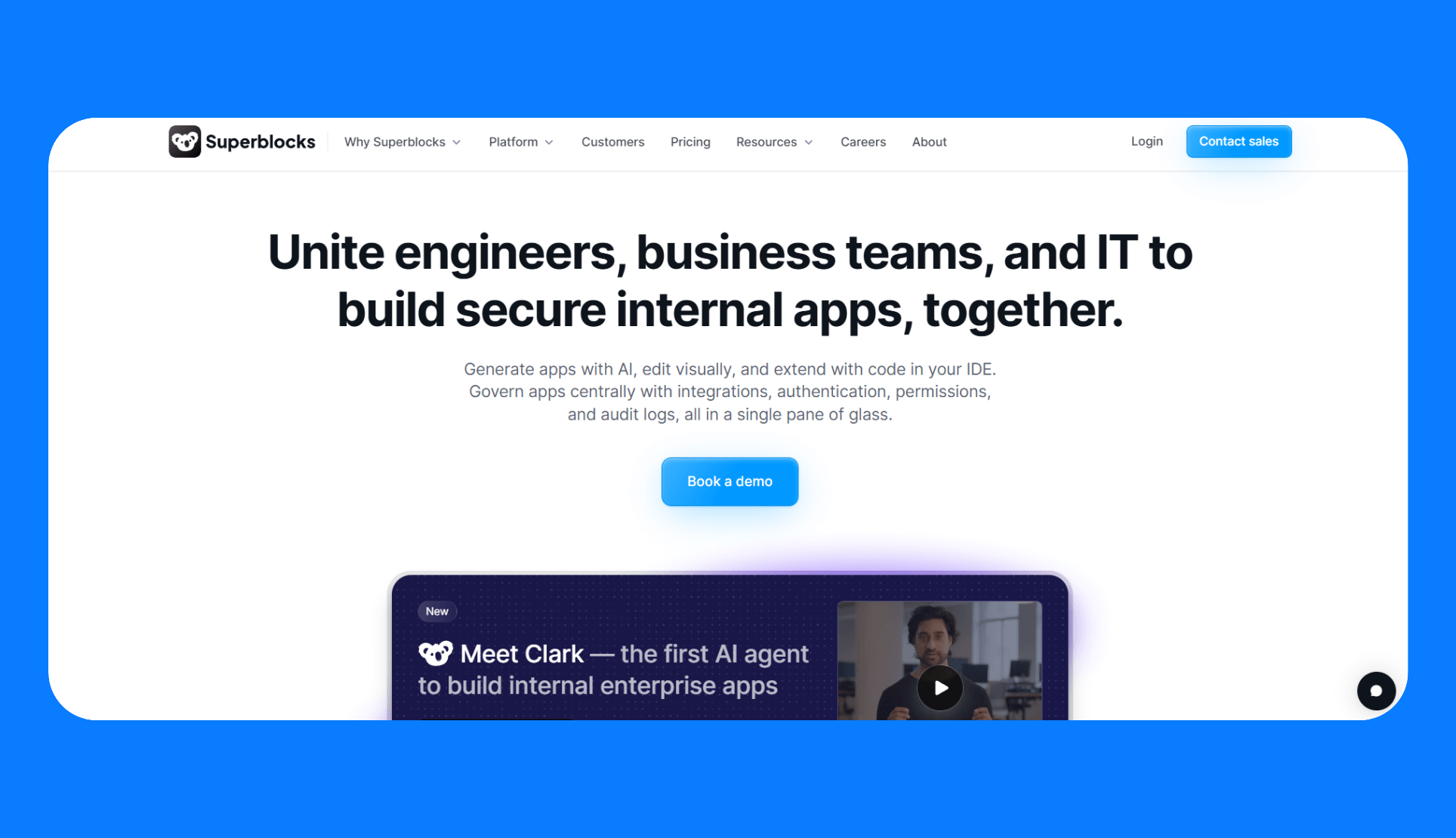
What it is: Superblocks is an AI-native internal tool development platform that helps operationally heavy enterprises reduce shadow IT/AI by providing a centralized, governed platform with deep integrations.
Who it’s for: CIOs, CTOs, and enterprise IT leaders who want to democratize internal tool development across semi-technical teams while keeping apps compliant, standardized, and under IT’s control.
Key features
- Three development modalities: Superblock’s AI agent, Clark, generates full-stack apps from natural language requirements. You can refine these apps in the drag-and-drop WYSIWYG editor or customize them locally in your preferred IDE. The two-way live sync keeps your app in sync with the visual builder.
- Centrally managed governance layer: It supports RBAC, SSO, audit logs, and granular permissions, all managed from a single admin panel. You can integrate with secret managers for secure credential management.
- AI app generation with guardrails: Clark generates apps that respect the design systems and best practices you define. You can also customize and sanitize prompts for safe outputs.
- Extensive integrations: Superblocks connects to any API, database, or SDLC system, including Git workflows and CI/CD pipelines with a seamless integrations layer.
- Forward-deployed engineers: The dedicated field engineering team provides onsite or virtual help during implementation.
Pros
- Engineers and business teams in your organization can build internal apps.
- Centralized control and visibility reduce shadow tools and promote standardization.
- You can easily integrate your tooling with your existing systems.
- SDLC integration enables collaboration within engineering teams.
- You can embed Superblocks apps within your own product or portal.
Cons
- The AI agent is still in beta.
- There’s no fully on-prem deployment option, though the on-prem agent keeps sensitive data in-network.
Pricing
Superblocks uses custom pricing based on the number of creators, end users, and your chosen deployment model.
Bottom line
Consider Superblocks if you have a growing backlog of internal tools and want to let semi-technical users build safely under IT governance.
2. UI Bakery

What it is: UI Bakery is a low-code platform for building internal tools. You can start from scratch in the visual editor, use pre-built templates, or build your app with the AI app generator.
Who it’s for: Teams that value self-hosting options and want the flexibility to run the entire platform on their own infrastructure.
Key features
- AI app generator: UI Bakery's AI generator creates CRUD applications from natural language prompts. It can build custom components and clone interfaces from uploaded images.
- Templates and pre-built integrations: The platform offers pre-built templates for common internal tool patterns and native connectors for databases, APIs, and third-party services.
- Deployment options: It supports deployments on its own cloud service, on-premises, and private cloud deployments.
Pros
- It supports JavaScript and Python code for custom logic.
- The pre-built components, templates, and AI accelerate development.
- It has a built-in database if you don’t want to connect to your own.
Cons
- Significant customizations to the AI-generated app require coding skills.
- You can't export application code, so migration to other platforms is difficult.
Pricing
UI Bakery is free for up to 5 users. You’ll get unlimited apps and data sources, 500K tokens for the AI generator, and 1000 workflow executions per month. The paid plans start at $6/month/user and $12/developer/month, billed annually.
Bottom line
The UI Bakery AI app generator does a solid job of scaffolding your applications. To edit the app, you’ll need to code. I couldn't find a visual editing option for the AI-generated app. However, starting from the visual builder or template options gives you access to the drag-and-drop editor.
3. Airtable
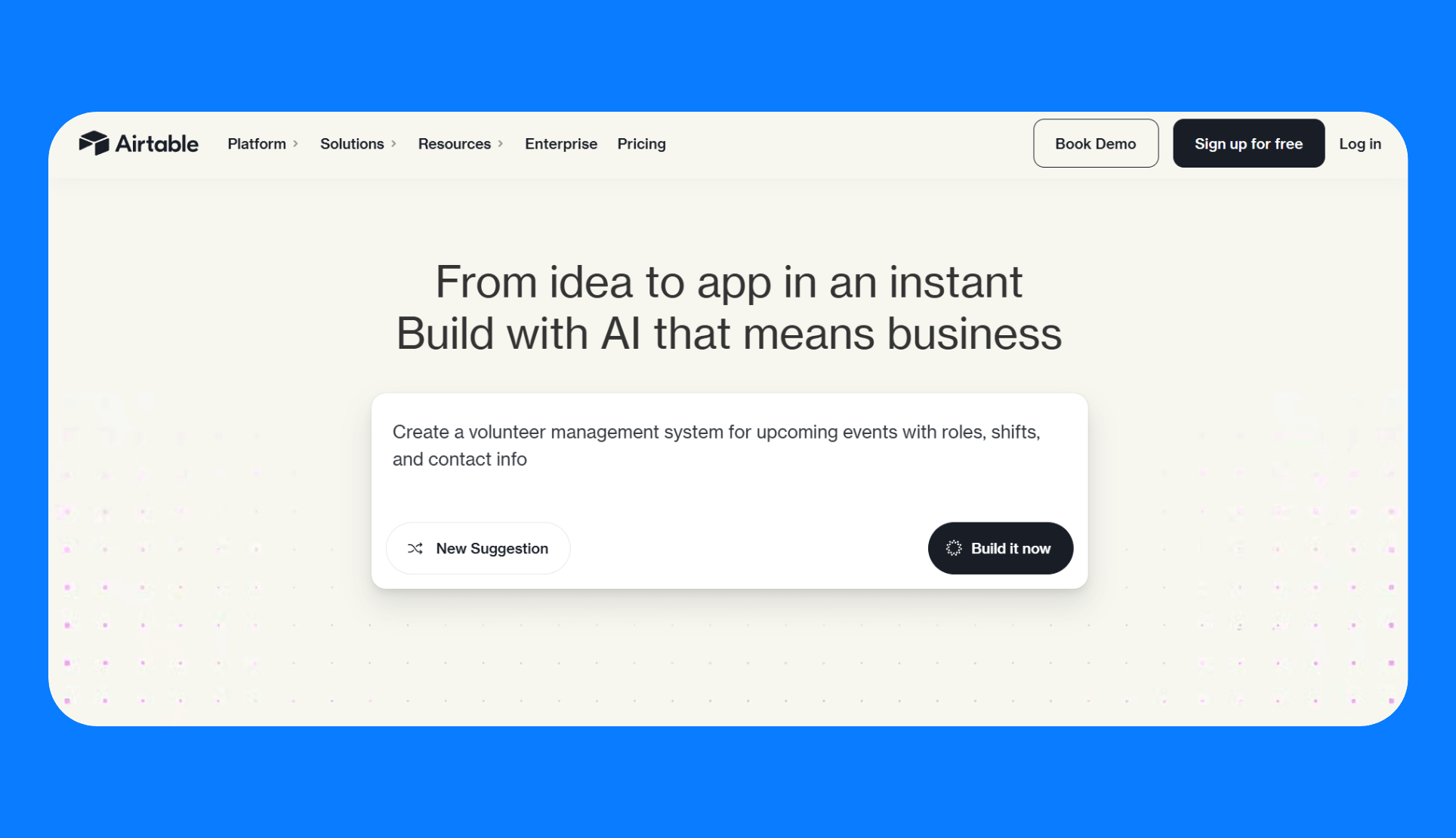
What it is: Airtable is a massively popular no-code platform that lets you build apps and automations on top of your data. The new Omni assistant helps users generate tables, interfaces, and automations conversationally.
Who it’s for: Teams that want to keep track of their data and build actions on top of it. It’s especially popular with marketing, HR, product ops, and project managers.
Key features
- Omni: Airtable’s conversational AI builder creates complete apps, including data tables, interfaces, and automations from natural language. It can also analyze data and provide insights.
- Collaboration and sharing: Airtable is multi-user with fine-grained permissions. You can share bases or interfaces with view or edit rights, and it keeps a revision history.
- Automations and scripting: Airtable includes an automation engine that allows you to trigger actions based on specific events. You can use the AI assistant to build the automations for you, build from a catalog of automation recipes, or use the builder to create from scratch.
Pros
- Omni generates apps that are fully editable using Airtable’s drag-and-drop tools.
- Real-time updates, commenting, and easy sharing simplify team collaboration.
- Enterprise customers can choose which AI models power Omni and enable AI selectively at the workspace level.
Cons
- Performance can slow down as bases grow very large.
- You must rebuild app logic and interfaces if you move off Airtable.
Pricing
Airtable’s free plan includes 500 AI credits/month, unlimited bases (up to 1,000 records each), 5 editors, and 100 automation runs. The Team plan is $24/seat/month and includes 15,000 AI credits per paid user, 50,000 records per base, and 25,000 automation runs.
Note: Asking Omni to build and iterate on your apps doesn’t consume AI credits.
Bottom line
Airtable is great for data-driven apps like directories, catalogs, project trackers, and other use cases where the core functionality is viewing and manipulating records. Omni makes it even easier to scaffold apps and automations.
4. Lovable

What it is: Lovable is an AI-driven app development platform that turns plain English prompts into full-stack React-based apps.
Who it’s for: Within enterprises, it’s most useful for product and design teams that want to quickly prototype apps and validate concepts before committing engineering resources.
Key features
- Prompt-to-app generation: Lovable generates the front-end UI, backend logic, and database schema via the Supabase integration from natural language prompts.
- Multiplayer AI editing: The platform supports collaborative editing. You can invite collaborators into the project you’re working on or add them to your workspace.
- Figma integration: Lovable accepts Figma designs as input. A designer could mock up an interface in Figma, and Lovable will turn it into a working app.
Pros
- Two-way sync with GitHub simplifies developer handoff.
- Non-coders can generate apps just by describing them, then refine with visual editing tools.
- You can deploy apps directly from Lovable or run them in preview mode for quick testing.
Cons
- Lovable is ideal for small-to-medium apps and MVPs.
- Budgeting for a credit-based system is less straightforward than flat seat licenses.
Pricing
Lovable has a free plan that gives users 5 credits daily (30 max monthly). Paid plans start at $25/month for 100 credits with the option to purchase additional credit packs.
Bottom line
Consider Lovable if you want to explore multiple ideas quickly without tying up engineering resources. Once a concept is validated, developers can step in to harden the codebase or rebuild it on a more resilient enterprise stack.
5. Softr
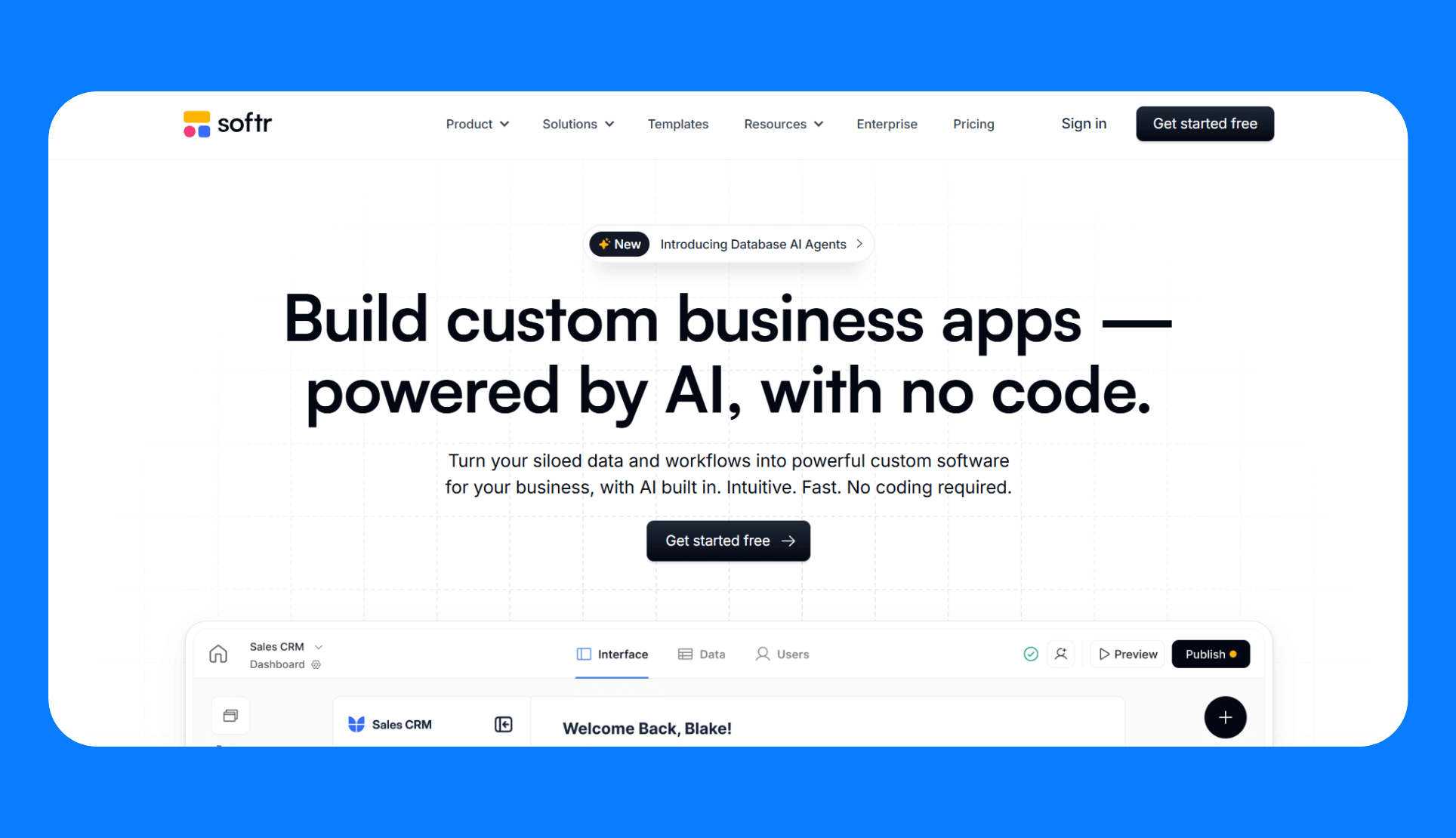
What it is: Softr is a no-code platform that turns your spreadsheet data into web apps. Its AI app generator works as a prompting layer to scaffold the initial app, but it’s constrained by Softr’s block-based design and limited logic.
Who it’s for: Business users or small teams that need to expose data in an app-like interface for customers, partners, or colleagues without involving a dev team.
Key features
- Visual app builder with blocks: Softr’s app editor lets you assemble pages using pre-built blocks. You drag and drop these blocks and customize text, images, and layout.
- Data source integration: The platform supports collaborative editing. You can invite collaborators into the project you’re working on or add them to your workspace.
- User permissions and access control: Softr has built-in user authentication and roles. It also supports sign-in with passwords, one-time codes, magic links, and SSO.
Pros
- It supports SEO settings, custom domains, and dynamic content pages for public-facing apps.
- You can easily create different content for different user groups.
- It includes a built-in relational database for centralizing your data.
Cons
- You can’t build or iterate on apps step by step with AI prompts after the initial scaffold.
- The AI generator doesn’t directly integrate with your data. You’ll need to link it manually.
Pricing
Softr’s free plan supports 1 published app, 10 app users, and 5,000 Softr database records. Paid plans start at $59/month for 3 published apps, 20 app users, and 50,000 database records.
Bottom line
Softr’s AI app generation is best if your use case fits into its supported app types, mainly client portals, internal tools, directories, and membership platforms. The app it generates is limited to Softr’s pre-built blocks and data patterns, so you won’t get custom workflows or unique UIs outside that model.
6. ToolJet
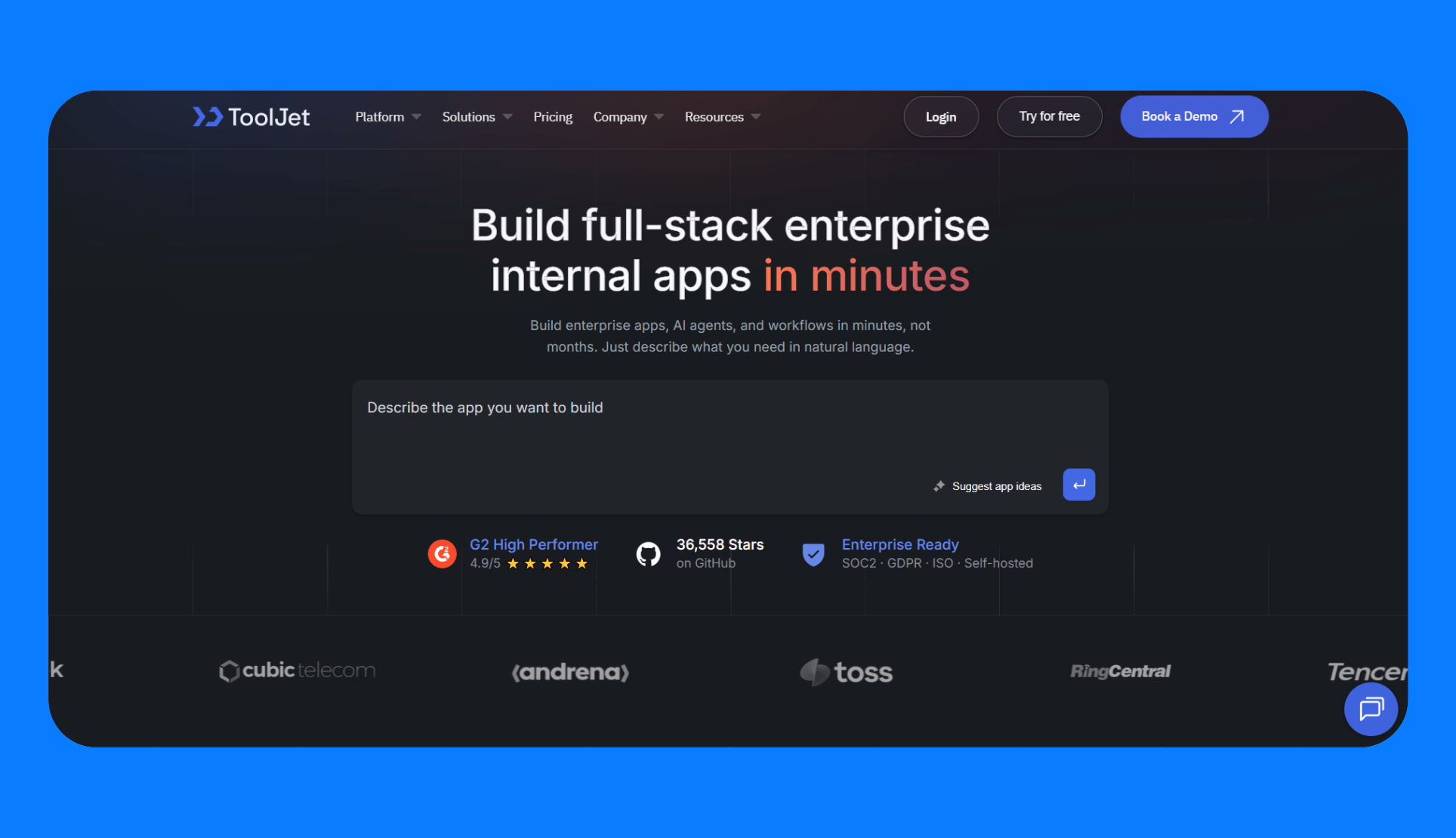
What it is: ToolJet is an open-source low-code platform for building internal tools and admin panels, similar to Retool. It includes a drag-and-drop UI builder and an AI generator that can scaffold apps, queries, and database schemas from natural language prompts.
Who it’s for: Teams that want an open-source solution for internal tools, with the flexibility to self-host the platform on their own infrastructure.
Key features
- Visual app builder: ToolJet offers a web-based builder with UI components (tables, forms, charts, etc.) to construct interfaces. You can bind these components to data sources and define actions (on click, on submit) with a few clicks.
- Data integrations: It supports a wide range of integrations, including SQL and NoSQL databases, APIs, and SaaS services. It also has an internal PostgreSQL-based database.
- AI integration: ToolJet’s AI generates a working scaffold including data models, UI components, and query logic.
Pros
- It offers self-hosting and managed cloud options.
- You can refine your app iteratively by issuing new prompts or making changes visually.
- It includes enterprise security features like SSO, custom access groups, audit logs, Git sync, and multiple environments.
Cons
- Self-hosting requires extra infrastructure and DevOps effort.
- The pricing for SSO and Git features is higher (at $249/builder/month) than most of the plans in this list.
Pricing
ToolJet’s free plan supports 2 builders, 50 end users, 2 apps, and no AI credits per month. Paid plans start at $24/builder/month and offer the free features plus 2000 AI credits per builder.
Bottom line
ToolJet is attractive if you want to avoid vendor lock-in. Self-hosting and setup, however, demand more technical investment compared to managed options.
7. Cursor
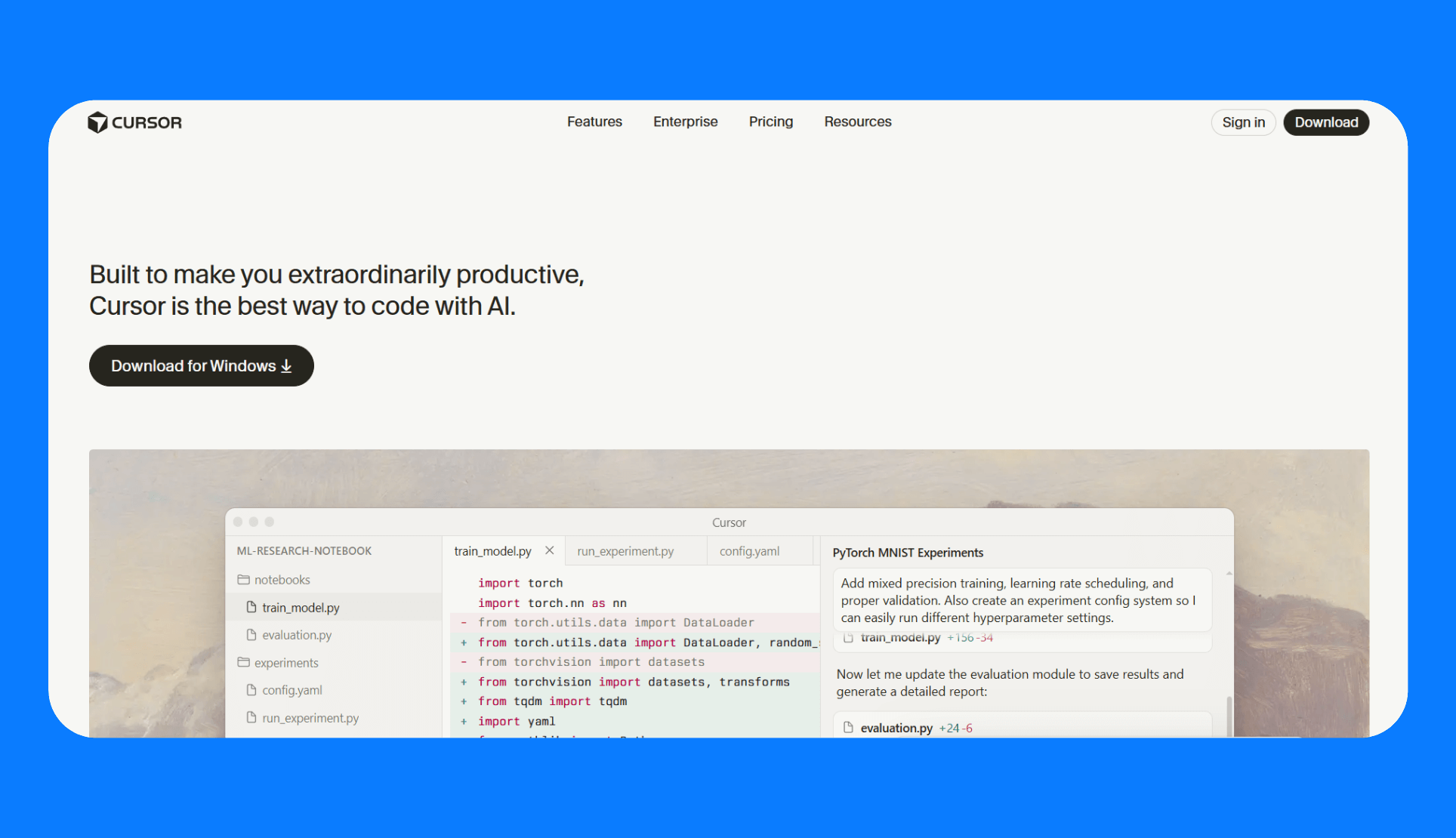
What it is: Cursor is an AI-powered coding assistant that turns natural language prompts into code. Its agent mode can create multiple code files and apply edits project-wide.
Who it’s for: Cursor stands out for technical users who want AI coding help but also need total control over tech stack, architecture, and deployment.
Key features
- Prompt to code: Developers can generate, refactor, or debug code across files simply by issuing natural language prompts in chat or inline.
- Codebase indexing: Cursor scans and indexes your entire codebase, so the AI can reference files, libraries, and even project docs for highly contextual suggestions.
- Agent mode: Cursor can handle tasks autonomously while keeping the developer in control for review and approval.
Pros
- The privacy mode ensures models don’t store your data or use it for training.
- Deep codebase understanding supports large-scale refactors or project-wide updates.
- It supports multiple LLMs (GP4, Claude, Gemini, Grok, DeepSeek), and lets you bring your own API keys for flexibility.
Cons
- Cursor can become slow and less responsive with very large codebases.
- It does not generate instantly deployable apps. You must edit, review, and run the code yourself.
Pricing
Cursor offers limited agent requests and tab completions in the free plan. The individual plans start at $20/month for unlimited tab completions and extended limits on agentic requests. Teams plans start at $40/user/month.
Bottom line
Cursor is ideal for engineering teams that want AI to accelerate coding, not replace it. It improves developer productivity through contextual code generation, refactoring, and project-wide editing.
How I tested these enterprise AI app generation platforms
I tested each platform by building a simple app and compared the results and the platform’s features against the needs of enterprise teams.
To test the platforms, I signed up for the free plan on each tool and attempted to build a simple CRUD app using each one. I kept notes on how easy it was to use and any friction points. I also reviewed official documentation, browsed app forums, and compared insights with third-party reviews.
What I looked for:
- Ease of use and speed: The whole point of AI app generation is faster development. I tested how quickly someone new could build a working app and whether the generated app needed tons of manual tweaking. I also checked what iteration options were available, whether code, visual editing, or just more prompts.
- Integration capabilities: Enterprise apps have to connect to databases, APIs, and external systems. I looked for built-in connectors and options for custom integrations.
- Governance: I looked for features like user roles, SSO, audit logs, version control, and on-prem or hybrid deployment options.
Which enterprise AI app generation platforms should you choose?
Superblocks is the best overall choice if you’re building internal tools. Consider Cursor for coding assistant and Lovable for quick prototyping.
Here are my specific recommendations:
- Choose Superblocks if you have a long backlog of internal tool requests and want to give domain experts development access while keeping IT's guardrails in place. It’s also a strong fit if you have data residency requirements. The hybrid model keeps your data in-network while you manage users and apps through Superblocks Cloud.
- Choose ToolJet if you specifically want an open-source solution you can self-host. Just know it'll cost more. Pricing runs higher than many competitors, and self-hosting means extra infrastructure and DevOps work.
- Choose UI Bakery if you want a cheaper alternative to ToolJet that you can also fully self-host.
- Choose Lovable if you need rapid prototyping. It’s great for validating ideas quickly before involving engineering.
- Choose Cursor if you want AI to speed up development in your existing stack.
- Avoid these tools if you need offline support or native mobile capabilities. All of the platforms in this list are web-first.
My final verdict
If you’re an IT leader prioritizing security, AI governance, and scalability of your internal tools, use Superblocks. For customer-facing apps, consider Lovable.
Use Superblocks for secure, governed internal tools at scale
Superblocks pairs AI app generation, visual building, and full-code customization under a enterprise-grade governance layer that you can trust.
We’ve looked at the key features that enable this, but just to quickly recap:
- Flexible development modalities: Teams can use Clark to generate apps from prompts, the WYSIWYG drag-and-drop editor, or code. Superblocks syncs the changes you make in code and the visual editor.
- AI guardrails: Every app built with Clark abides by organizational standards for data security, permissions, and compliance. This addresses the major LLM risks of ungoverned shadow AI app generation.
- Centrally managed governance layer: It supports granular access controls with RBAC, SSO, and audit logs, all centrally governed from a single pane of glass across all users. It also integrates with secret managers for safe credentials management.
- Keep data on prem: It has an on-prem agent you can deploy within your VPC to keep sensitive data in-network.
- Extensive integrations: It can integrate with any API or databases. These integrations include your SDLC processes, like Git workflows and CI/CD pipelines.
Ready for fast, secure internal tool generation? Book a demo with one of our product experts.
Frequently asked questions
What is an enterprise AI application?
An enterprise AI application is software built with AI to solve business problems at scale while meeting enterprise requirements for security, governance, and integration.
What’s the best enterprise AI app builder for internal tools?
Superblocks is the best enterprise AI app builder for internal tools because it has a centralized governance layer, extensive integrations, and a hybrid deployment option.
What’s the difference between enterprise AI and Gen AI?
Enterprise AI refers to artificial intelligence solutions that are specifically designed to securely solve business problems within an organization, while Generative AI (Gen AI) is a class of algorithms and models that create new content based on patterns learned from vast datasets.
Are there any free AI app builders?
Yes, Bolt.diy from Stackblitz and Firebase Studio from Google are free AI app builders. There are also free tiers for tools like Airtable, Replit, and GitHub Copilot that you can use.
What is the 30% rule in AI?
The 30% rule suggests that AI tools can automate or generate code for about 70% of typical tasks. The last 30% involving edge cases, architectural decisions, compliance, security, and domain-specific complexity still require human developers.
What features should enterprises prioritize in AI app generation platforms?
Enterprises should prioritize governance (SSO, RBAC, audit logs), integration capabilities, scalability, and deployment flexibility.
How do you evaluate ROI for AI app generation platforms?
To evaluate ROI for AI app generation platforms, track developer hours saved, and how much faster teams build apps, then balance those gains against platform costs.
Stay tuned for updates
Get the latest Superblocks news and internal tooling market insights.
You've successfully signed up
Request early access
Step 1 of 2
Request early access
Step 2 of 2
You’ve been added to the waitlist!
Book a demo to skip the waitlist
Thank you for your interest!
A member of our team will be in touch soon to schedule a demo.
Table of Contents



